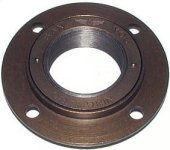DISH
10 W
- Joined
- Oct 19, 2009
- Messages
- 94
There seems to be a lot of interest in mounting multiple freewheels on the rear wheel. Here's a trick I've used in the past.

You will need the following parts, a wheel with a hub that takes a screw on freewheel, of course the freewheels, and the secret part, the bearing cup from the bottom bracket of an older bicycle.
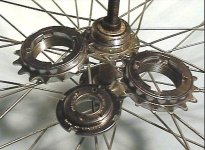
Mount the first freewheel as you normally would:
View attachment 7
Screw the bottom bracket bearing cup into the mounted freewheel:
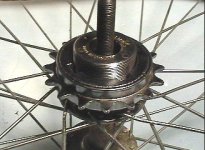
If you want to alter the spacing you can put washers on the hub, use freewheel spacers which come in various sizes (I have 0.5 mm up to at least 4 mm so I know they come in at least those sizes), or use the lock ring from the bottom bracket bearing cup as a spacer.
Now screw the second freewheel on:
View attachment 6
I know, I know. You wanted a HUGE gear for the motor and a small gear for the human side.
Enter the bolt on freewheel:

I dropped an 80 tooth scooter freewheel on the bolt on freewheel for illustration. This takes smaller gauge chain but is compatible with the gears on many scooter motors. You can also get gears for standard bicycle chain that will bolt on to this freewheel.
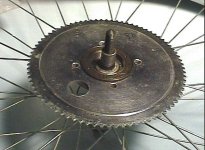
Now screw the bottom bracket bearing cup into the bolt on freewheel. (Remember to mount the gear to the freewheel using bolts and nylock nuts or at the very least lock washers, otherwise it will come loose!)

80 tooth scooter gear and 16 tooth standard bicycle chain gear both mounted on freewheels on the same wheel hub:
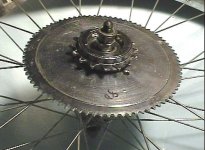
Side view of the 80 tooth and 16 tooth freewheel gears:
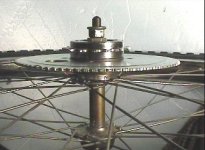

You will need the following parts, a wheel with a hub that takes a screw on freewheel, of course the freewheels, and the secret part, the bearing cup from the bottom bracket of an older bicycle.

Mount the first freewheel as you normally would:
View attachment 7
Screw the bottom bracket bearing cup into the mounted freewheel:

If you want to alter the spacing you can put washers on the hub, use freewheel spacers which come in various sizes (I have 0.5 mm up to at least 4 mm so I know they come in at least those sizes), or use the lock ring from the bottom bracket bearing cup as a spacer.
Now screw the second freewheel on:
View attachment 6
I know, I know. You wanted a HUGE gear for the motor and a small gear for the human side.
Enter the bolt on freewheel:

I dropped an 80 tooth scooter freewheel on the bolt on freewheel for illustration. This takes smaller gauge chain but is compatible with the gears on many scooter motors. You can also get gears for standard bicycle chain that will bolt on to this freewheel.

Now screw the bottom bracket bearing cup into the bolt on freewheel. (Remember to mount the gear to the freewheel using bolts and nylock nuts or at the very least lock washers, otherwise it will come loose!)

80 tooth scooter gear and 16 tooth standard bicycle chain gear both mounted on freewheels on the same wheel hub:

Side view of the 80 tooth and 16 tooth freewheel gears:



